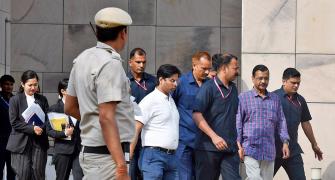The numbers appear to make for a happy tale: The Indian economy beat forecasts to record a GDP growth of 8.9 per cent in the first quarter of 2006, propelled by growth in the manufacturing sector.
That's a contrast with past years, when the services sector was the engine of the economy, making India synonymous with the concept of outsourcing and in the process creating a whole new class of professionals and entrepreneurs.
This time, from April through June, the manufacturing sector rose 11.3 per cent, higher than a growth rate of 10.7 per cent reported in the same period last year. But India's key services recorded a growth of only 8.9 per cent, compared with 8.8 per cent in the last year. And some economists believe the government isn't doing enough to move these numbers along.
Finance Minister P Chidambaram announced that this was the highest first quarter growth recorded since 2000-01. "My expectation is we can continue to maintain a growth rate close to 8 per cent every quarter provided we continue to follow prudent policies," he told reporters soon after the numbers were released.
But economists say the government also needs to resolve nagging infrastructure issues and ensure that populist policies don't hinder growth.
Slideshows:
Top Ten Hottest Jobs In India
The Forbes 40 India
"In some sense, we should start getting used to these growth numbers coming out of India. This is the third or fourth year running that we'll have about 8 per cent growth," says Surjit Bhalla, managing director of Oxus Research and Investments, an Indian economic research, asset management and emerging-markets advisory firm.
But Bhalla adds: "What has the government done to bring this about? The short answer is nothing, other than the central bank maintaining a competitive exchange rate. Though the good news is the capacity of the government to do damage is severely restricted, since the growth momentum is self-sustaining."
The ruling Congress-led coalition in India is limited in its ability to reform because it needs the support of Communist parties to stay in power. Labour reforms are one area where the government hasn't done too much to change strict policies that make it difficult to hire and fire based on market demand.
Equally worrying are India's nagging problems with infrastructure and water, especially with Western companies opening more and more bases in the country.
Slideshows:
Asia's Fab 50 - Hong Kong and India
Top Ten Richest Indians
"One downside (to the growth story) is infrastructure remaining a bottleneck," says Nagesh Kumar, director general of RIS, an autonomous research body that was set up with financial support from the Indian government.
But Kumar is also quick to point out that with the manufacturing sector booming, India now has two engines of growth - services and manufacturing. And he too feels that the momentum in these sectors is self-sustaining.
Former centrall minister and economist Dr Yoginder Alagh says India's growth in the coming years would be sustained by three factors.
"The major big-ticket reform is India's move towards complete capital account convertibility," says Alagh, adding: "Most of East Asia is very mercantilist on the exchange rate, but we are creating an environment where any foreign company can bring in any money and take it out almost at the click of a button."
The other factor for growth is the central government's control of its fiscal deficit, says Alagh, who also serves on the boards of leading Indian companies. And finally, there's a turnaround in agriculture after about ten years.
Rebutting skepticism from some economists over how long India will be able to sustain this growth, Alagh points out that both domestic demand and export growth are strong and will remain so for a while.
Like China did in the past, India will now ride through the slight slowing down of growth in other Organization for Economic Cooperation and Development countries, Alagh predicts.
And though the country's booming growth rates are doing little to bridge the chasm between the rich and poor, the market optimism is evident on the streets of India's metropolises. Top international brands are wooing consumers with increasingly large pockets, swank new shopping malls now dot city landscapes and India's real estate market is reported to be growing at about 30 per cent annually.
It now remains up to the government to keep inflation in check.
India's central bank, the Reserve Bank of India, has its next review of interest rates on Oct 31. It's uncertain whether the bank will again raise the key short-term interest rate. It has already raised the rate three times this year to check inflationary pressures.
Slideshow:
India's New Billionaires






